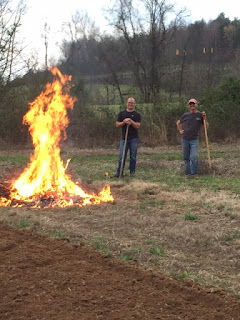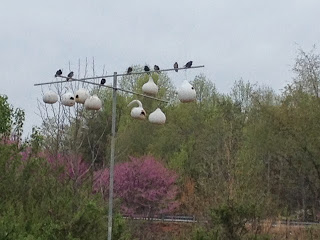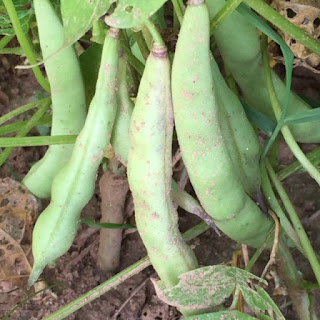Spring, 2016, yields some of the most spectacular early blossoms on record for Western NC. One beautiful display reminds me of a neighbor who planted azaleas not long before his death. Looking at the expanse of brilliant red blooms, a delight for passersby, I remember the man who placed young plants, his friendly wave, a wide smile that proclaimed youthful spirit and his twinkling eyes. These azaleas, now mature plants, announce joyful exuberance and share beauty, a living legacy to the gardener.
A stroll around my home also reminds me of friends and family, some who are alive and others who shared tangible reminders of their earthly time. Here, Ruth's peonies, deliciously fragrant, there, Aunt Meda's irises, large blossoms very different from my grandmother's small delicate purple ones. Tim's Azaleas, Spectacular 2016 Show
Janet's Hellebores thrive in wooded oak leaf beds and a large pot holds nodding bleeding hearts, a gift from Clark. 
Hellebores Re-Seed to Grow New Plants
Along with plants, I count heirloom seeds as gifts. When I hold these small treasures in my palm, I feel their life force and look forward to watching seedlings emerge from soil, thrive and bloom, produce fruit, vegetables and seed for another season, before the plant dies.Perennial Bleeding Hearts Thrive as Container Plants
Plant cycles are reminders of our own human mortality. Should we not all hope for productive days that allow us to create beauty where we live? This spring, plan to share a plant or seeds with a special friend or family member and create your own living legacy. Someday, when a blossom is especially beautiful or a fruit unusually sweet, someone may fondly recall your life and smile at the memory. 
Beans, Peas, Peanuts & Sunflowers: Seeds from my Grandmother
Wednesday, April 13, 2016
Planting Legacies
Tuesday, April 5, 2016
Spring Cleaning
Those pesky, forgetful squirrels. Every Spring, I am surprised when plants bloom in unexpected places, moved to new locations by squirrels that intend to enjoy them as Winter food, but overlook the hidden treats. When blossoms appear far from areas I planted, I blame squirrels, but when I discover hidden foods in freezers and pantry shelves, there is no one to blame but myself.
A lone daffodil blooms where a squirrel planted the bulb
 |
| Burning weeds, brush and broken stakes adds soil nutrients |
 | |
| Last Year's Purple Martin Group |
Back at home, spring cleaning tasks are a different sort of work. With Winter bowing to Spring's arrival, backyard gardens, farms and farmer's markets will soon yield fresh food for the dinner table. While cutting the season's first asparagus spears, I realized it was time to take inventory of preserved harvests in freezers, refrigerators and pantry shelves and make a concerted effort to use as much as possible to make room for this year's bounty.
 |
| A bounty of roasted tomato sauce, preserved last summer |
 |
| Roast fresh tomatoes with onion, garlic, peppers & herbs, then freeze |
Spring Cleaning Puttanesca Sauce
*Although this Italian sauce's origins are murky, one widely circulated story is that prostitutes would place simmering pots of this fragrant sauce near their establishment's windows, in order to lure male customers. Another source gives credit to a restaurant owner who was told to make "any kind of garbage" for hungry guests. Regardless of its beginnings, there are no rules for combining ingredients in this sauce; if it is something you like, add it. With tomato base and a good balance of salty, your results will be delicious. Serve over pasta or rice, along with crusty bread for a hearty meal.
2 cups roasted tomato sauce with onion and garlic
1/4 cup pickled eggplant (for recipe, see Eggplant)
1/4 cup dried tomatoes, chopped
1/4 - 1/2 cup roasted peppers, chopped
1-2 tablespoons capers
1/4 cup Kalamata olives, roughly chopped
Oregano, dried or fresh, salt and pepper to taste
Combine and simmer all ingredients in a medium pot over low heat until fragrant and bubbly. Optional: top with grated Parmesan or Pecorino Romano cheese.
Tuesday, March 29, 2016
Traditional Gardening
Almost everyone has a family tradition. Many of my favorite childhood memories are tied to annual special events or practices. Wearing my grandmother's handmade Mother's Day corsages, sharing my mother's New Year's Day breakfasts with friends and family, enjoying a last-day-of-summer-vacation trip to Blowing Rock and Good Friday planting were some of our family traditions.
 |
| Planting Beans on Good Friday is a Family Tradition |
Throughout the world, many gardeners celebrate Good Friday by placing seeds or plants in the ground. In our area, potatoes are the likely choice, but since my grandmother always planted beans on that Holy day, I keep her tradition alive and plant the same seeds she inherited from her mother. My heirloom seed beans are White Mountain Half Runners and trace back five generations to the immigrant woman, Mary Schmidt Bean, called "Polly" by her family, who brought them to the US from Germany in the early 1800s.
 |
| Polly Schmidt Bean, US Immigrant & Seed Saver |
Last year's April 3rd Good Friday planting restored my supply of pure seed, but since the 2016 traditional planting day is a week earlier, it is likely our Western NC gardens could still expect a visit from Jack Frost; therefore, I only planted a twenty-five foot row of Granny's beans. With luck and good weather, these seeds will produce beans to enjoy eating fresh from the vines by early summer. When the crop is mature, the most beautiful bean pods will dry to serve as seed for next spring.
 |
| Good Friday proved to be a glorious Spring day |
Along with last year's seed, I also, just for luck, added a few beans my grandmother saved from her own garden. Granny died in 1986 and these seeds are over thirty years old, but as I dropped seven "magic" beans into rich soil, I recited the names of all the family seed savers I know. Polly, Dovie, Mary Elizabeth, Lora, Gladys, Cindy and Kate. While my daughter, Kate, is not yet a full-fledged seed saver, she is making plans to grow her own garden and I have no doubt she will include Granny's special beans and appreciate these inherited heirloom treasures as much as I do.
 |
| Save seeds from the largest, most beautiful, beans |
Wednesday, March 16, 2016
The Lost Recipe
When I was a child, my extended family gathered at my grandmother's home for holiday meals. Granny spent days preparing for such occasions and her table groaned from the weight of heaping bowls of green beans, creamed corn, buttered carrots and peas, platters of fried chicken, ham and deviled eggs. Gravy simmered on the stove, an array of cakes and pies lined the side counter and her fluffy biscuits, pulled from the oven as guests arrived, wafted aroma throughout the house. Family members enjoyed Granny's potatoes, either mashed or stirred in a salad mix, but the hands-down favorite potato dish was something she called "soupy potatoes."
Preparing Field for Potato Planting
If comfort food could be defined by a single dish, it would have to be Granny's soupy potatoes. Slices of creamy potato, thick, rich broth, seasoned with salt and buttery goodness. When Granny gave me her recipe collection, shortly before her death, in 1986, I did not think to see if it included favorite dishes. By the time I wished to try a hand at recreating taste memories, it was too late to ask for the soupy potato or sausage cream gravy recipes. Granny often made these and probably never consulted a written recipe, relying on memory, texture and taste for consistent results. Several times, I attempted to make both, with disappointing results and resolved myself to the fact that the recipes were lost. And then, a recent visit with a relative yielded a surprising gift . . .
Soupy Potatoes Make Rich Broth
My cousin, Ruth, an heirloom seed saver and unofficial family historian, welcomed me to her home and asked if I would like to see her personal recipe collection. As someone who should be enrolled in a twelve-step program to combat a cookbook addiction, I jumped at the opportunity and whipped out my phone to snap photos of delicious looking recipes, recorded in Ruth's handwriting. Turning pages of cake, casserole and pie recipes, my hands began to shake when I read the words, "Soupy Potatoes." Quickly, I scanned the four ingredients: Potatoes, Water, Salt, Butter. No cream? Could it really be that simple? Thanking Ruth for sharing a special gift, I looked forward to sharing Soupy Potatoes with my family.
 |
| Kate prepares potato "eyes" for planting |
 |
| Joe & Richard Clear Brush From Potato Field |
 |
| Kate and Bob Plow, 2011 |
 |
| Kate with 2016 "workhorse" |
 |
| Cut Potatoes in Row |
When Richard tasted the first bite, he breathed, "Comfort." As we ate, he recalled elementary school cafeteria meals in Boone, back when workers actually cooked food for children. I listened to my family's raucous laughter and chatter, a sound memory conjured by familiar taste, as I savored Soupy Potatoes.
Potatoes. Water. Salt. Butter. It really was that simple.
*Note: For best results, avoid supermarket russets. Those GMO spuds are waxy and lack the flavor of "real" potatoes. If you do not grow your own, shop at local farmer's markets or make a friend who grows potatoes.
 |
| Soupy Potatoes |











